Morphology of rice 水稻形态学
- 格式:pdf
- 大小:835.03 KB
- 文档页数:24
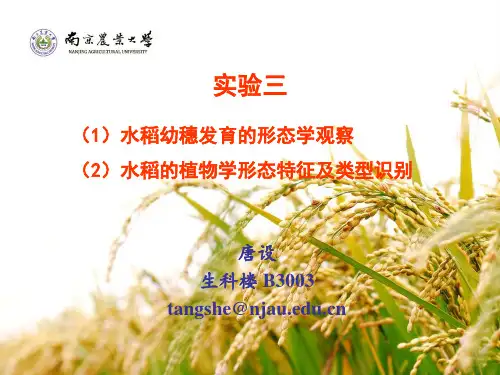
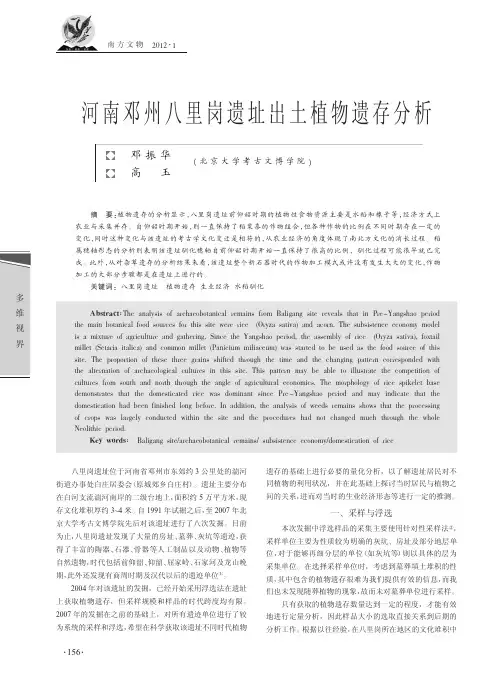
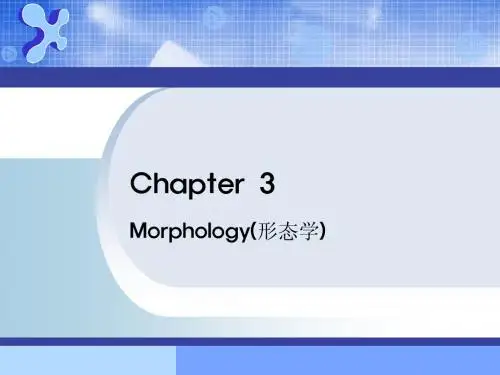
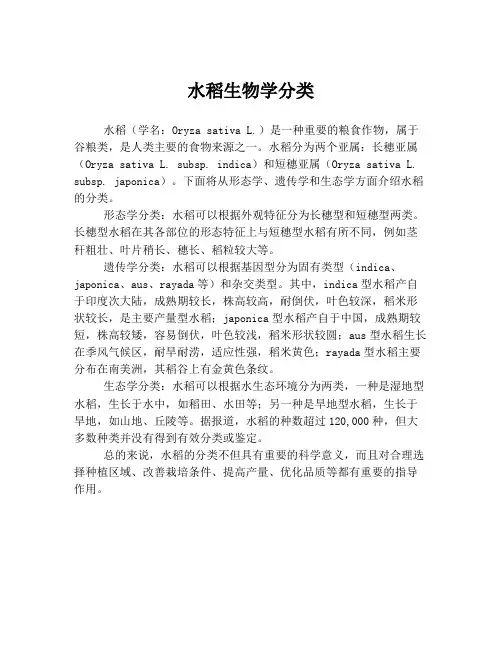
水稻生物学分类
水稻(学名:Oryza sativa L.)是一种重要的粮食作物,属于谷粮类,是人类主要的食物来源之一。
水稻分为两个亚属:长穗亚属(Oryza sativa L. subsp. indica)和短穗亚属(Oryza sativa L. subsp. japonica)。
下面将从形态学、遗传学和生态学方面介绍水稻的分类。
形态学分类:水稻可以根据外观特征分为长穗型和短穗型两类。
长穗型水稻在其各部位的形态特征上与短穗型水稻有所不同,例如茎秆粗壮、叶片稍长、穗长、稻粒较大等。
遗传学分类:水稻可以根据基因型分为固有类型(indica、japonica、aus、rayada等)和杂交类型。
其中,indica型水稻产自于印度次大陆,成熟期较长,株高较高,耐倒伏,叶色较深,稻米形状较长,是主要产量型水稻;japonica型水稻产自于中国,成熟期较短,株高较矮,容易倒伏,叶色较浅,稻米形状较圆;aus型水稻生长在季风气候区,耐旱耐涝,适应性强,稻米黄色;rayada型水稻主要分布在南美洲,其稻谷上有金黄色条纹。
生态学分类:水稻可以根据水生态环境分为两类,一种是湿地型水稻,生长于水中,如稻田、水田等;另一种是旱地型水稻,生长于旱地,如山地、丘陵等。
据报道,水稻的种数超过120,000种,但大多数种类并没有得到有效分类或鉴定。
总的来说,水稻的分类不但具有重要的科学意义,而且对合理选择种植区域、改善栽培条件、提高产量、优化品质等都有重要的指导作用。
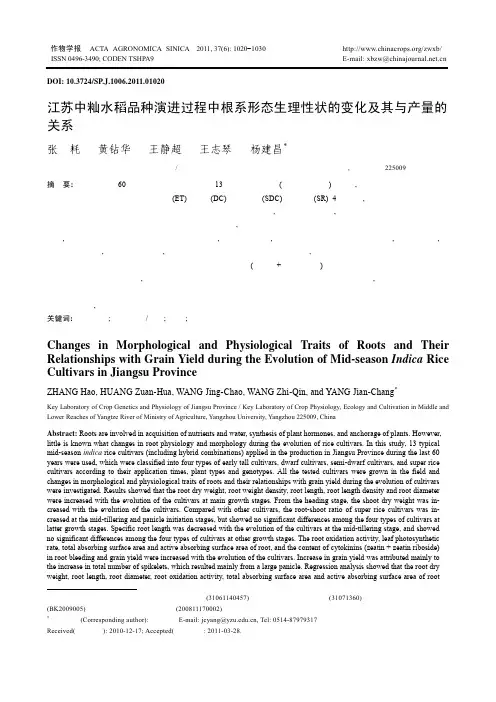

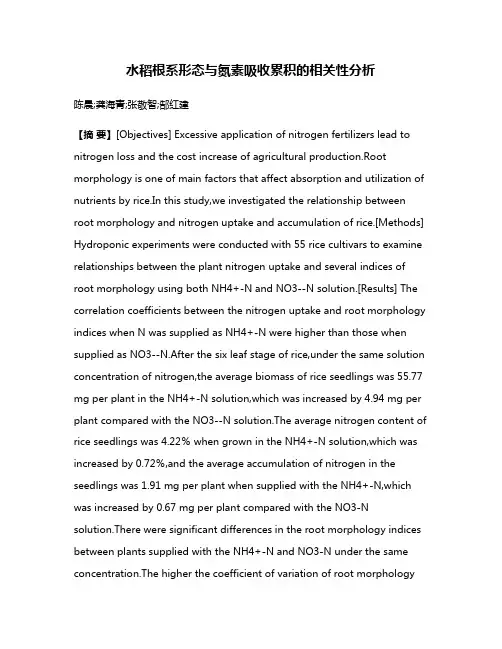
水稻根系形态与氮素吸收累积的相关性分析陈晨;龚海青;张敬智;郜红建【摘要】[Objectives] Excessive application of nitrogen fertilizers lead to nitrogen loss and the cost increase of agricultural production.Root morphology is one of main factors that affect absorption and utilization of nutrients by rice.In this study,we investigated the relationship between root morphology and nitrogen uptake and accumulation of rice.[Methods] Hydroponic experiments were conducted with 55 rice cultivars to examine relationships between the plant nitrogen uptake and several indices of root morphology using both NH4+-N and NO3--N solution.[Results] The correlation coefficients between the nitrogen uptake and root morphology indices when N was supplied as NH4+-N were higher than those when supplied as NO3--N.After the six leaf stage of rice,under the same solution concentration of nitrogen,the average biomass of rice seedlings was 55.77 mg per plant in the NH4+-N solution,which was increased by 4.94 mg per plant compared with the NO3--N solution.The average nitrogen content of rice seedlings was 4.22% when grown in the NH4+-N solution,which was increased by 0.72%,and the average accumulation of nitrogen in the seedlings was 1.91 mg per plant when supplied with the NH4+-N,which was increased by 0.67 mg per plant compared with the NO3-N solution.There were significant differences in the root morphology indices between plants supplied with the NH4+-N and NO3-N under the same concentration.The higher the coefficient of variation of root morphologywas,the higher the greater difference between rice cultivars was.The root branch number was most highly correlated with the root morphology indices,whereas the mean root diameter was the least correlated.These differences reflected that there was a larger variation in root branching values,and less variation in mean root diameters among the 55 rice cultivars.The total root volume,total root area,total root length and branching number were significantly correlated with biomass,nitrogen content,and nitrogen accumulation in rice plants at the seedling stage,and the correlation coefficients were in order:the total root volume > the total root area > total root length > the number of branches.The correlations between the nitrogen uptake and the indices of root morphology when plants were supplied with NH4+-N were higher than those when supplied with NO3--N.[Conclusions] The total root volume,total root area,total root length,and the number of branches may be important indicators for evaluating the nitrogen use efficiency ofrice at the seedling stage.%[目的]氮肥过量施用,不仅造成氮肥大量流失,还增加了农业生产成本,对生态环境带来了巨大的威胁.水稻根系形态作为影响养分吸收和利用的主要因素之一,明确其与氮素吸收累积的相关性是提高氮素利用效率、降低环境污染的有效途径.[方法]利用营养液培养方法,研究了55个水稻品种在NH4+-N和NO3--N供应条件下苗期植株生物量、氮含量和氮素累积量及其与根系形态指标的相关性.[结果]在NH4+-N培养下,水稻营养指标与根系形态指标的相关性高于其在NO3-N培养下的相关性.在相同供氮水平下,供应NH4+-N的水稻苗期平均生物量为55.77 mg/plant,比供应NO3-N的量高4.94 mg/plant;水稻苗期平均氮含量为4.22%,比供应NO3--N的高0.72%;水稻苗期平均氮累积量为1.91 mg/plant,比供应NO3--N的苗期平均氮累积量高0.67mg/plant.在NH4+-N和NO3-N两种氮素形态培养条件下,水稻根系形态指标品种间根尖数变异系数最大,平均根系直径变异系数最小.总根体积、总根面积、总根长、分枝数四个形态指标与植株生物量、植株氮含量、植株氮累积量相关性最为显著,且相关系数(r)呈总根体积>总根面积>总根长>分枝数的规律.在NH4+-N培养下的水稻营养指标与根系形态指标的相关性要高于其在NO3-N培养下的相关性.[结论]水稻苗期总根体积、总根面积、总根长、分枝数可作为水稻氮高效评价的重要指标.【期刊名称】《植物营养与肥料学报》【年(卷),期】2017(023)002【总页数】9页(P333-341)【关键词】水稻;根系形态;生物量;氮累积量;相关性分析【作者】陈晨;龚海青;张敬智;郜红建【作者单位】安徽农业大学资源与环境学院,安徽合肥230036;安徽农业大学资源与环境学院,安徽合肥230036;安徽农业大学资源与环境学院,安徽合肥230036;安徽农业大学资源与环境学院,安徽合肥230036【正文语种】中文根系在植物养分吸收和生长发育过程中起着极为重要的作用。

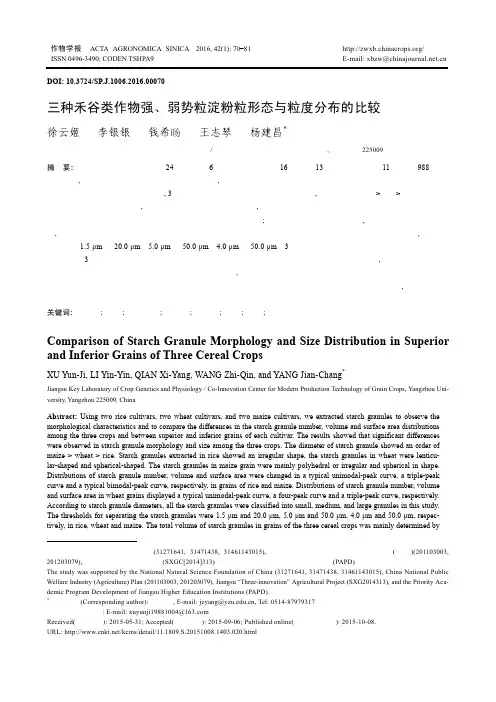
作物学报 ACTA AGRONOMICA SINICA 2016, 42(1): 70 81/ISSN 0496-3490; CODEN TSHPA9E-mail: xbzw@本研究由国家自然科学基金项目(31271641, 31471438, 31461143015), 中央级科研院所基本科研业务费专项(农业)(201103003, 201203079), 江苏省农业三新工程项目(SXGC[2014]313)和江苏高校优势学科建设工程资助项目(PAPD)专项经费资助。
The study was supported by the National Natural Science Foundation of China (31271641, 31471438, 31461143015), China National Public Welfare Industry (Agriculture) Plan (201103003, 201203079), Jiangsu “Three-innovation” Agricultural Project (SXG2014313), and the Priority Aca-demic Program Development of Jiangsu Higher Education Institutions (PAPD).*通讯作者(Corresponding author): 杨建昌, E-mail: jcyang@, Tel: 0514-********第一作者联系方式: E-mail: xuyunji19881004@Received(收稿日期): 2015-05-31; Accepted(接受日期): 2015-09-06; Published online(网络出版日期): 2015-10-08. URL: /kcms/detail/11.1809.S.20151008.1403.020.htmlDOI: 10.3724/SP.J.1006.2016.00070三种禾谷类作物强、弱势粒淀粉粒形态与粒度分布的比较徐云姬 李银银 旸钱希 王志琴 杨建昌*扬州大学江苏省作物遗传生理国家重点实验室培育点 / 粮食作物现代产业技术协同创新中心, 江苏扬州225009摘 要: 本研究以水稻品种武运粳24和扬两优6号、小麦品种扬麦16和宁麦13及玉米品种登海11和农乐988为试验材料, 分别提取其成熟期强、弱势粒的淀粉粒, 观察比较不同作物及其强、弱势粒间淀粉粒形态和淀粉粒数量、体积和表面积分布特性。
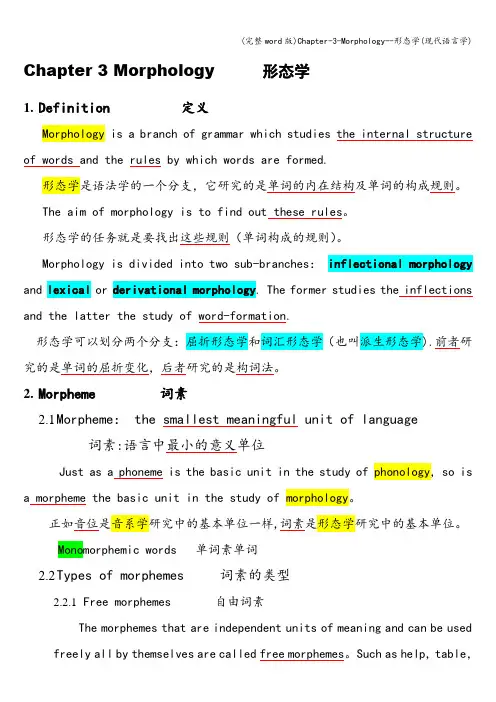
Chapter 3 Morphology 形态学1.Definition 定义Morphology is a branch of grammar which studies the internal structure of words and the rules by which words are formed.形态学是语法学的一个分支,它研究的是单词的内在结构及单词的构成规则。
The aim of morphology is to find out these rules。
形态学的任务就是要找出这些规则(单词构成的规则)。
Morphology is divided into two sub-branches:inflectional morphology and lexical or derivational morphology. The former studies the inflections and the latter the study of word-formation.形态学可以划分两个分支:屈折形态学和词汇形态学(也叫派生形态学).前者研究的是单词的屈折变化,后者研究的是构词法。
2.Morpheme 词素2.1Morpheme: the smallest meaningful unit of language词素:语言中最小的意义单位Just as a phoneme is the basic unit in the study of phonology, so is a morpheme the basic unit in the study of morphology。
正如音位是音系学研究中的基本单位一样,词素是形态学研究中的基本单位。
Monomorphemic words 单词素单词2.2Types of morphemes 词素的类型2.2.1Free morphemes 自由词素The morphemes that are independent units of meaning and can be used freely all by themselves are called free morphemes。
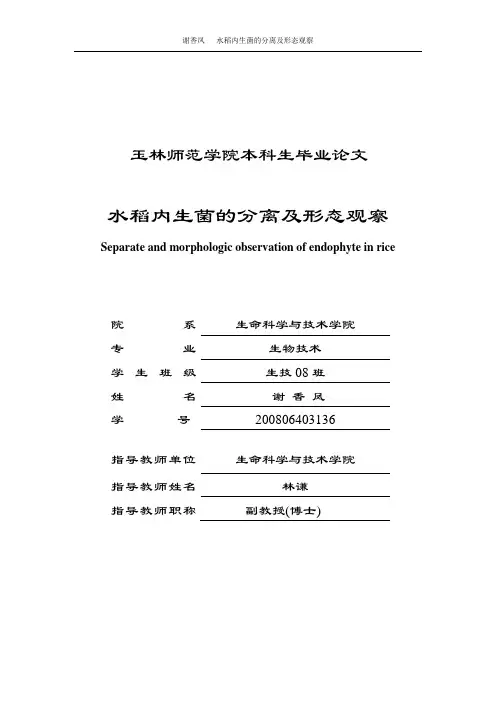
玉林师范学院本科生毕业论文水稻内生菌的分离及形态观察Separate and morphologic observation of endophyte in rice院系生命科学与技术学院专业生物技术学生班级生技08班姓名谢香凤学号200806403136指导教师单位生命科学与技术学院指导教师姓名林谦指导教师职称副教授(博士)水稻内生菌的分离及形态观察生技08班谢香凤指导教师林谦摘要水稻是世界上最重要的粮食作物之一,是亿万人口的基本营养来源。
随着世界人口的日益增多和耕地面积的急剧减少,水稻增长措施的研究已经成为当今农业科学研究的重要课题。
经平板培养法分离出水稻内生真菌和细菌,再采用平板落计数法对水稻内生菌的根、茎、叶长出的内生菌的数量测定,并分别取出它们的平均值,再用F检验根茎叶有无显著性差异。
然后用显微镜观察水稻的内生菌的形态。
水稻细菌的根茎叶生长趋势表明,水稻内生细菌在植株器官中的分布以根部数量最多,其次是叶,茎最少;而水稻真菌的根茎叶生长趋势表明:水稻内生真菌在植株器官中以根部数量最多。
但分布明显比内生细菌少。
通过对内生菌的分离及形态观察,并在显微镜观察可以鉴别水稻内生菌属于哪个属,研究水稻的内生菌的分布情况,可以更有效的利用植物内生菌为我们谋福利。
关键词: 水稻、内生细菌、内生真菌、分离、形态观察Separate and morphologic observation of endophyte in rice Biotechnology Class 08 Xie Xiang-fengSupervisor Lin-qianAbstractRice is one of the most important grain crop in the world. It is the primary nutrition source of billionaire population. Along with world population increases every day and arable areas reduce sharply, nowadays, the study of rice increase have became an important topic in agricultural sciences research. Through plating method separates endophyte fungi and bacteria of rice, than adopt enumeration by platecount method to determine or measure the quantity of rice endophytic roots, stems and leaves. Their average value were separate derived. Than we can use F-test to examine whether roots, stems and leaves have significant difference or not. At last, electron microscope observe morphology of this endophyte fungi and bacteria in rice. The bacterial growth tendency of stem, root and leaf in rice indications that endophytic bacteria in rice plants with roots in the distribution of organs account for the greatest number, followed by leaves, stems at least. However, the growth tendency of stem , root and leaf in rice endophytic fungi indications that endophytic fungi in rice plants with roots in the distribution of organs account for the greatest number. But the distribution of endophytic fungi is significantly less than the endophytic bacteria. Separating endophyte , then indentify endophyte by morphologic observation and electron microscope observation. we can make use of endophyte in rice and leap benefits by researching distribution of plant endophyte in rice.Key words: Rice, Endophytic bacteria, Endophytic fungi, Separate, Morphologic observation目录1前言 (4)1.1植物内生菌的定义 (4)1.2植物内生菌的研究进展 (5)1.3植物内生菌的多样性 (5)1.4水稻中的内生菌 (6)1.4.1水稻内生细菌的起源 (6)1.4.2水稻内生细菌多样性 (6)1.5水稻内生菌的生物学作用 (7)1.5.1促进宿主植物生长 (7)1.5.2增加宿主对环境威迫的抗性 (8)1.5.3与昆虫竞争宿主植物的能源供应 (8)1.6本研究的目的和意义 (8)2 材料和方法 (10)2.1 材料 (10)2.2 仪器 (10)2.3实验方法 (10)3 结果与分析 (12)3.1水稻内生菌的菌落数分布 (12)3.1.1水稻内生细菌的菌落数分布: (12)3.1.2水稻内生真菌的菌落数分布 (16)4 讨论与结果 (20)4.1 讨论 (20)4.2 结论 (20)致谢 (21)参考文献 (22)1前言1.1植物内生菌的定义植物内生菌(E ndophyte)是指那些在其生活史的一定阶段或全部阶段生活于健康植物的各种组织和器官内部或细胞间隙的真菌或细菌。
0引言中国是以稻米为主要粮食的国家,同时也是稻米生产和消费的第一大国,因此,水稻在保障中国粮食安全中有着举足轻重的作用。
但由于人口的增加和耕地面积的减少,粮食安全问题日益严峻,如何提高单产仍然是水稻育种的主要目标。
人们早就注意到,良好的株型是水稻获得高产的基础,早在20世纪60年代,就有学者提出“理想株型”的概念[1]。
20世纪半矮秆和杂种优势的利用使水稻单产实现了2次飞跃,也是建立在株型改良的基础上。
叶片是水稻最重要的同化器官,其形态与植株的受光形态和光合效率密切相关,在水稻的生长、发育和产量形成过程中起重要作用。
因此,良好的叶形是水稻获得高产的重要保证。
叶形可以解析为叶长、叶宽、叶厚、叶面积、叶片卷曲度和直立性。
前4个因子可概述为叶片大小因子,它们与叶片的卷曲度和直立性往往有一定的联系,如叶片较窄而短的一般表现为叶片直立,而宽且长的则多为披叶,叶片卷曲或较厚也有利于叶片直立[2]。
叶片直立性与植株受光形态关系密切,对光能利用率有重要的影响。
研究表明,叶长、叶宽、叶角、叶卷度和叶基金项目:广东省自然科学基金“叶片厚度在水稻高产中的作用研究”(S2011010000983);广东省农业科学院院长基金“水稻剑叶厚度的QTL 定位”(201505)。
第一作者简介:陈达刚,男,1979年出生,广东番禺人,助研,硕士,主要从事水稻遗传育种研究。
通信地址:510640广东省广州市天河区五山金颖东一街3号,Tel :020-********,E-mail :dagangchen05@ 。
收稿日期:2014-12-23,修回日期:2015-02-25。
水稻叶厚性状的研究进展陈达刚1,2,周新桥1,2,李丽君1,刘传光1,2,陈友订1,2(1广东省农业科学院水稻研究所,广州510640;2广东省水稻育种新技术重点实验室,广州510640)摘要:叶厚是重要的叶形因子和株型改良的选择指标,在水稻理想株型和高产育种研究中备受关注。
收稿日期:2020-05-09基金项目:黑龙江省教育厅备案项目(1351MSYZD002)作者简介:赵世明(1995-),男,河北辛集人,在读硕士研究生,研究方向为微生物学,(电话)183****7607(电子信箱)****************;通信作者,律凤霞(1967-),教授,主要从事植物病理学及食用菌栽培的教学与科研工作,(电话)137****6717(电子信箱)**************。
稻瘟病是水稻栽培中的重要病害之一,中国南北稻区均有稻瘟病发生[1],病害流行地区轻则减产10%~50%,严重罹病的稻田甚至绝收[2]。
稻瘟病在水稻的各个时期及各个部位均有可能发病,尤其是棚内育苗期、插秧后分蘖、抽穗初期更易感病[3-5]。
植物病害的防治应做到以防为主治疗为辅,最大限度规避化学防治,减少农药残留,有利于消费者身体健康,有利于有机农业的良性循环和健康发展[6,7]。
而分离纯化获得植物病原菌纯培养物,是了解该病原菌生物学特性和生态学习性的前提,是植物病害防控及抗病育种的基础[8-11]。
本研究从牡丹江市不同水稻栽培地采集疑似感染稻瘟病的水稻叶片,用PDA 培养基进行病原菌纯化初培养,通过观察菌落黑色素产生及分生孢子的形态进行初筛鉴别;采用CTAB 法提取菌丝DNA ,以稻瘟病菌特异引物进行PCR 扩增,对扩增产物进行测序及NCBI 网站比对验证,获得纯化后的病原稻瘟菌。
水稻稻瘟病病原菌分离纯化及分子鉴定赵世明,王美玲,律凤霞(牡丹江师范学院生命科学与技术学院,黑龙江牡丹江157012)摘要:从牡丹江市不同水稻栽培地采集疑似感染稻瘟病的水稻叶片,用PDA 培养基进行病原菌分离纯化培养,通过观察菌落黑色素及分生孢子的形态进行初筛鉴别;采用试剂盒提取菌丝DNA ,利用稻瘟病菌特异引物进行PCR 扩增,对扩增产物进行测序及Nucleotide Blast 比对。
结果表明,6个栽培区采集病样经初筛确定5株有黑色素分泌且观察到其分生孢子,测序证实其中2个样品PCR 产物序列相同,且与NCBI 网站公布的半知菌亚门的灰梨孢(Pyricularia grisea )高度同源,确定获得稻瘟病菌纯菌株。
水稻新型胞质不育系L-orfH79与其同核异质YTA的比较作者:李佳洋田泽李威涛刘学群王春台谭艳平来源:《安徽农业科学》2019年第15期摘要[目的]验证新型细胞质不育系L-orfH79与其同核异质的近等基因系HL-CMS YTA的区别。
[方法]用orfH79和orf290这2种分子标记对L-orfH79和YTA进行分子鉴定,并比较其花粉染色特性、花粉育性、结实率及orfH79表达量。
[结果]分子标记鉴定结果显示L-orfH79只含有不育基因orfH79、不含有orf290,YTA同时含有orfH79和orf290。
L-orfH79花粉的淀粉沉积比YTA更少,L-orfH79花粉大小均匀,而YTA的花粉形态不一。
L-orfH79花粉育性、套袋结实率及自然结实率(都低于10%)略高于YTA(都低于5%)。
当L-orfH79中引入恢复基因Rf5或者Rf6后花粉形态和颜色都恢复正常。
抽穗期L-orfH79剑叶中的 orfH79表达量低于YTA,在L-orfH79中引入Rf5或者Rf6后会减少orfH79的表达量。
[结论]L-orfH79是不同于YTA的新型细胞质雄性不育系,L-Rf5、L-Rf6可作为其恢复系。
关键词水稻;细胞质雄性不育系;L-orfH79;育性中图分类号 S511文献标识码 A文章编号 0517-6611(2019)15-0097-04doi:10.3969/j.issn.0517-6611.2019.15.027开放科学(资源服务)标识码(OSID):Abstract[Objective]In order to verify the difference between the new cytoplasmic male sterile line LorfH79 and its isonuclear alloplasmic sterile lines HLCMS YTA.[Method]LorfH79 and YTA were identified by molecular markers orfH79 and orf290, of which pollen dyeing characteristics,pollen fertility, seed setting rate and expression level of orfH79 were compared.[Result]It showed that both orfH79 and orf290 in YTA, while LorfH79 only contained orfH79 but not orf290 by molecular marker identification. The starch deposition of LorfH79 pollen was less than that of YTA. The size of LorfH79 pollen was uniform, but the morphology of YTA pollen was different. The pollen fertility, bagging seed setting rate and natural seed setting rate of LorfH79(all below 10%)were slightly higher than YTA (all below 5%). Pollen morphology and color returned to normal when the restorer gene Rf5 or Rf6 was introduced into LorfH79. The expression of orfH79 in flag leaves of LorfH79 was lower than that of YTA. The expression of orfH79 reduced in sterile line LorfH79 after introducing Rf5 or Rf6.[Conclusion]LorfH79 is a new cytoplasmic male sterile line that different from YTA. LRf5 and LRf6 can be used as restorer lines.Key words Rice;Cytoplasmic male sterility;LorfH79;Fertility基金项目湖北省技术创新专项重点项目(2018BFC360);湖北省自然科学基金项目(2018CFB481);中央高校基本科研业务费专项(CZY18029,CZP17017)。
水稻形态学特征镉Rice, Morphological Characteristics, Cadmium水稻的形态学特征及其与镉的关系Rice is a major cereal crop that exhibits distinct morphological characteristics.水稻是一种主要的粮食作物,具有明显的形态学特征。
These characteristics include its elongated leaves, panicles bearing numerous grains, and the root system that anchors it in the soil.这些特征包括其狭长的叶片、承载众多谷粒的稻穗以及将其固定在土壤中的根系。
Cadmium (Cd) is a heavy metal that can have negative impacts on rice growth and quality.镉是一种重金属,对水稻的生长和品质具有负面影响。
When present in the soil, cadmium can be absorbed by rice plants, accumulating in various tissues and potentially causing toxicity.当镉存在于土壤中时,可被水稻植株吸收,并在各种组织中积累,可能导致毒性。
Therefore, understanding the morphological characteristics of rice and its interaction with cadmium is crucial for ensuring safe and sustainable rice production.因此,了解水稻的形态学特征及其与镉的相互作用对于确保水稻的安全和可持续生产至关重要。
When the seed germinates in well-drained and well-aerated soil, the coleorhiza, a covering enclosing the radicle or primary root, protrudes first.Fig. 1 - The coleorhiza protrudes first.Shortly after the coleorhiza appears, the radicle or primary root breaks through the covering.Fig. 2 - Radicle or primary root breaks through the covering.Two or more sparsely branched seminal roots follow. These roots eventually die and are replaced by many secondary adventitious roots.Fig. 3 - Seminal rootsIf the seed germinates in water, the coleoptile, a covering enclosing the young shoot, emerges ahead of the coleorhiza. The coleoptile emerges as a tapered cylinder.Fig. 4 - Coleoptile emerging as a tapered cylinder.The mesocotyl or basal portion of the coleoptile elongates when the seed germinates in soil, and in darkness. It pushes the coleoptile above the soil surface.Fig. 5 - Mesocotyl pushing the coleoptile above the soil surface.The first seedling leaf, or primary leaf, emerges from the growing seed. It is green and shaped like a cylinder. It has no blade. The second leaf is a complete leaf. It is differentiated into a leaf blade and a leaf sheath.Fig. 6 - First and second seedling leaf.The seedling will grow and develop branched tillers. Parts of the rice tiller include the roots, culm and leaves. Mature roots of the rice plant are fibrous and produce smaller roots called rootlets. All roots have root hairs to absorb moisture and nutrients.Fig. 7 - Parts of the rice tiller.There are two kinds of mature roots:1. secondary adventitious roots2. adventitious prop roots.Fig. 8 - Types of roots.Secondary adventitious roots are produced from the underground nodes of young tillers.Fig. 9 - Secondary adventitious roots.As the plant grows, coarse adventitious prop roots often form above the soil surface in whorls from the nodes of the culm.Fig. 10 - Adventitious prop roots.The culm, or jointed stem of the rice, is made up of a series of nodes and internodes.Fig. 11 - Culm, nodes, and internodes.Young internodes are smooth and solid. Mature internodes are hollow and finely grooved with a smooth outer surface. Generally, internodes increase in length from the lower to the upper portions of the plant. The lower internodes at the plant base are short and thick.Fig. 12 - Young and mature internodes.The node is the solid portion of the culm. The node or nodal region bears a leaf and a bud. The bud is attached to the upper portion of the node and is enclosed by the leaf sheath. The bud may give rise to a leaf or a tiller.Fig. 13 - Leaf, node, and bud.Early tillers arise from the main culm in an alternate pattern. Primary tillers originate from the lowermost nodes and give rise to secondary tillers. Secondary tillers produce tertiary tillers.Fig. 14 - Primary tillers.Fig. 15 - Secondary tillers.Fig. 16 - Tertiary tillers.The node or nodal region of the culm will bear a leaf.Fig. 17 - Leaf.Leaves are borne alternately on the culm in opposite directions. One leaf is produced at each node. Varieties differ in the number of leaves produced.Fig. 18 - Leaves alternate on the culm in opposite directions.The topmost leaf below the panicle is the flag leaf. The flag leaf contributes largely to the filling of grains because it supplies photosynthetic products, mainly to the panicle.Fig. 19 - Flag leaf.The leaf sheath and leaf blade are continuous.Fig. 20 - Leaf sheath and blade.A circular collar joins the leaf blade and the leaf sheath.Fig. 21 - Leaf collar.The leaf sheath is wrapped around the culm above the node.Fig. 22 - Leaf sheath and culm.The swelling at the base of the leaf sheath, just above the node, is the sheath pulvinus. It is sometimes incorrectly referred to as the node.Fig. 23 - Sheath pulvinus.Leaf blades are generally flat. Varieties differ in blade length, width, thickness, area, shape, color, angle and pubescence.Fig. 24 - Different varieties with varying blade characteristics.With many parallel veins on the upper surface of the leaf, the underside of the leaf blade is smooth with a prominent ridge in the middle; the midrib .Fig. 25 - Parallel veins on upper surface.Fig. 26 - Leaf midrib.Most leaves possess small, paired ear-like appendages on either side of the base of the blade. These appendages are called auricles . Auricles may not be present on older leaves. Another leaf appendage is the ligule , a papery membrane at the inside juncture between the leaf sheath and the blade. It can have either a smooth or hair-like surface. The length, color, and shape of the ligule differ according to variety.Fig. 27 - Ligule and auricle.Fig. 28 - Rice and grassy weed comparisonAlthough similar, rice seedlings are different from common grasses. While rice plants have both auricles and ligules, common grassy weeds found in rice fields normally do not have these features. These characteristics are often helpful in identifying weeds in rice fields when the plants are young.The terminal component of the rice tiller is an inflorescence called the panicle. The inflorescence or panicle is borne on the uppermost internode of the culm. The panicle bears rice spikelets, which develop into grains.Fig. 29 - Rice panicle.The panicle base often appears as a hairlike ring and is used as a dividing point in measuring culm and panicle length. The panicle base is often called the neck.Fig. 30 - Panicle base (neck).The panicle axis is continuous and hollow except at the nodes where branches are borne.Fig. 31 - Panicle axis.The swellings at the panicle axis where the branches are borne are referred to as the panicle pulvinus.Fig. 32 - Panicle pulvinus.Each node on the main panicle axis gives rise to primary branches which in turn bears secondary branches. Primary branches may be arranged singly or in pairs.Fig. 33 - Secondary and primary branch.The panicles bear spikelets, most of which develop into grains. These spikelets are borne on the primary and secondary branches. The spikelet is the basic unit of the inflorescence and panicle. It consists of the pedicel and the floret.Fig. 34 - Spikelets.The floret is borne on the pedicel.Fig. 35 - Floret and pedicel.The rudimentary glumes are the laterally enlarged, cuplike apex of the pedicel. The rudimentary glumes are the lowermost parts of the spikelet. During threshing, the rudimentary glumes are separated from the rest of the spikelet.The sterile lemmas are small, bractlike projections attached to the floret. The rachilla is a small axis that bears the single floret. It is between the sterile lemmas and the floret.Fig. 36 - Rudimentary glumes, sterile lemmas, and rachilla.The rachilla, sterile lemmas and the rudimentary glumes all support the floret. The floret includes the lemma, palea, and the flower.Fig. 37 - FloretThe larger protective glume covering the floret is called the lemma and the smaller one is referred to as the palea.Fig. 38 - Palea and lemma.Both the lemma and palea have ridges referred to as nerves. The lemma has five while the palea has three. The middle nerve of the lemma can be either smooth or hairy.Fig. 39 - Nerves.The lemma has a constricted structure at its end called the keel. In some varieties, the keel is elongated into a thin extension, the awn.Fig. 40 - Awn and keel.| Print | E-mailThe floret contains a flower. The flower consists of a pistil (female organ) and six stamens (male organs).Fig. 41 - Pistil.Fig. 42 - Stamens.The stamens have two-celled anthers borne on slender filaments.Fig. 43 - Anthers and filaments.The pistil contains one ovule and bears a double-plumed stigma on a short style.Fig. 44 - Stigma, style, and ovule.At the flower’s base near the palea are two transparent structures known as lodicules. The lodicules thrust the lemma and palea apart at flowering to enable the elongating stamens to emerge out of the open floret. The lemma and palea close after the anthers have shed their pollen.Fig. 45 - Lodicule.The rice grain is the ripened ovary, with the lemma, palea, rachilla, sterile lemmas and the awn firmly attached to it.Fig. 46 - Rice grain.The rice hull includes the lemma and palea and their associated structures – the sterile lemmas, rachilla, and awn.Fig. 47 - Rice hulls.The dehulled rice grain is called caryopsis, commonly referred to as brown rice because of three brownish pericarp layers that envelope it. Next to the pericarp layers are the two tegmen layers and the aleurone layers.Fig. 48 - Tagmen, pericap, and aleurone layers.The remaining part of the grain consists of the endosperm and the embryo. The endosperm provides nourishment to the germinating embryo. The embryo lies on the belly side of the grain and is enclosed by the lemma. It is the embryonic organ of the seed.Fig. 49 - Endosperm and embryo.The embryo contains the plumule (embryonic leaves) and the radicle (embryonic primary root).Fig. 50 - Plumule and radicle.。